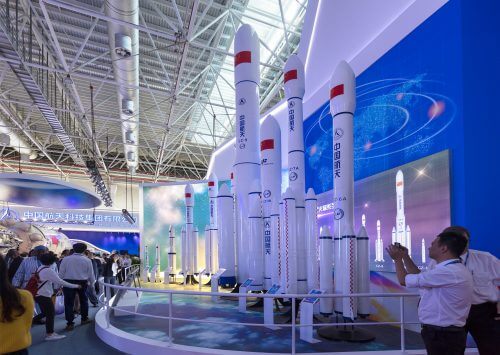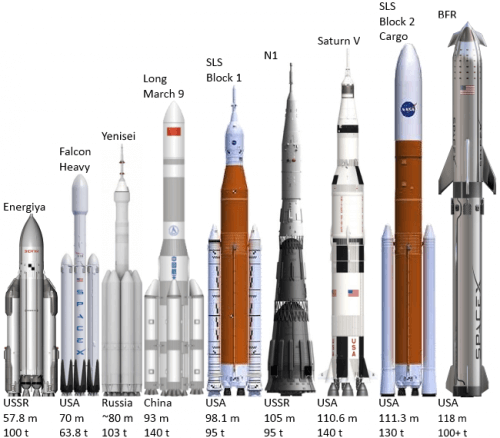Long March 9 will be capable of lifting a 140-ton payload into low Earth orbit, or a 50-ton spacecraft into lunar transfer orbit. The huge rocket will also be capable of delivering a 44-ton payload to a Mars transfer orbit

Chinese scientists are developing what is expected to be the most powerful rocket in the world, according to a senior researcher.
Li Hong, deputy general manager of China Aerospace Science and Technology Corp, said the Long March 9 heavy-lift super rocket will be capable of lifting a 140-ton payload into low Earth orbit, or a 50-ton spacecraft into lunar transfer orbit. The huge rocket will also be capable of carrying a 44-tonne payload to a Mars transfer orbit, he added. He said at the second session of the 13th Political Consultative Conference of the Chinese People's National Committee in Beijing. The researcher is a member of the national political advisory body.
The carrying capacity of Long March 9 is five times that of Long March 5 - currently China's most powerful launch vehicle. The 5-story Long March 20 has a takeoff weight of 869 tons and a maximum payload capacity of 25 tons for low Earth orbit.
Lee also stated that the length of Long March 9 will be close to one hundred meters and the diameter 9.5 meters, and it will be powered by a new generation kerosene/liquid oxygen engine with a thrust force of 500 tons. If research and development progress well, Long March 9 will make its first flight around 2030, when it will allow China to land astronauts on the moon and take humans and probes beyond the moon and into deep space, Li said.

Today, the most powerful rocket in the world is the Falcon Heavy of the United States, which was designed and manufactured by SpaceX. It can carry a payload of more than 63 tons into low Earth orbit, according to SpaceX. Historically, the most powerful rocket ever built was the US Saturn V, which helped the US send astronauts to the moon. It had the ability to bring a payload of about 130 tons into low Earth orbit.
Planners at the Chinese Academy of Launch Vehicle Technology in Beijing are responsible for Long March's overall design. The Aeronautical Propulsion Technology Academy in Xi'an, Shaanxi Province develops its engines.
Engineers at both academies have been focusing on 12 key technologies that will be used in the new rockets since 2016, when the first research program for the massive machine was approved by the government.
So far, the rocket's overall plan has undergone internal technical evaluations by China Aerospace Science and Technology Corp. experts and is awaiting government approval, said Sheng Zhi, head of the company's space exploration program.
He said that engineers are performing tests on important parts that will be assembled in the rocket. The company estimates that about 9 Long March 2030 rockets will be needed each year from 2035 to XNUMX in China to meet the country's strong demand for heavy-lift rockets at the time, Sheng said.
In addition, he said the company is also developing models for medium weight lifting such as Long March 6A and Long March 8.

4 תגובות
to conan There were reports that the Chinese are planning solar fields in space, which will absorb energy from the sun and transmit it to the earth, but it is possible that they also have plans to take over the moon and/or Mars... In any case, according to many, the future is in space, so you should prepare. D.A. Technologies must be updated and renewed, otherwise we retreat. It seems to me that the Chinese are much more serious than the Americans in calculating the cost/benefit of the launches (but it turns out that they are no less ambitious) and as a result it is possible that the motivation to continue investing - and in a more focused way - is stronger for them than the Americans who spread out with different technologies across the solar system and the Chinese's progress in technologies in certain issues (which are not necessarily related to the study of Triton and Pluto) will eventually overtake the Americans.
And here is another question: How can missiles of the same type be able to perform completely different tasks?!? I mean that the Long March 9 is also intended to bring astronauts and equipment into orbit around the Earth, both to bring astronauts to the Moon and also to leave the Earth and reach Mars; After all, it has three stages (as the Saturn-5 had) - but each of them has a known thrust and predetermined properties - so how can one type of missile perform three tasks that differ from each other in such a significant way???
Two questions:
1. The Chinese announced the launch of 10 rockets, each of which can bring about 140 tons into orbit around the Earth; The question is, what exactly are they planning to do there? Launching such a weight is far beyond building a space station.
Remember my words: there will be - at least until the end of the Chinese launches and publication (perhaps only partial) of images from American spy satellites - countless conspiracy theories, such as the placement of "kinetic weapons" or tests in space of the use of antimatter for propulsion or attack purposes.
2. Between the Apollo 11 landing on the moon in 1969 and the planned Chinese manned landing on the moon in 2030 there is a difference of about 60 years; In my opinion, this is the winning proof that perfectly shows the huge gap between American and Chinese technologies.
I like China's ambition. Such missiles are only worth the development if they are flown with such frequency #CancelSLS
Is it known that China is working on a manned spacecraft for deep space? If so, will they launch it on a CZ9 or go with a constellation approach of a separate launch to low orbit and a transition stage rendezvous?
Personally, I am very interested in the CZ8 and any other reusable launcher.
And, I really like China's preference for using strap-on boosters that use liquid fuel.